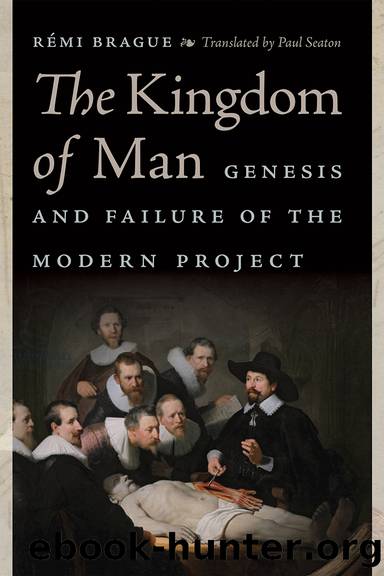The Kingdom of Man by Rémi BRAGUE

Author:Rémi BRAGUE
Language: eng
Format: epub
Publisher: University of Notre Dame Press
Published: 2018-09-14T00:00:00+00:00
The Artificial Man
A further step is taken with the dream of an artificial man, now no longer a product of nature, but of technology. Man thus finds himself supplanted by something that pertains to the human because it is produced by him, but that leaves it behind insofar as it is no longer natural.
The idea of an artificial man is ancient. According to Polybius, Nabis, king of Sparta, possessed an animate statue by which he dismembered debtors who refused to pay him back.14 The first occurrence in the Middle Ages is in an Arabic version of the legend of Salaman and Absal. A pseudo-Platonic text, the Laws of Plato or Book of the Cow, gives directions for fabricating a rational animal, but it seems that it is a demon, not a human. In a passage that âcontains the oldest mention of a human-automaton,â the several alchemists writing in Arabic, whose works are known under the nom de plume of Jabir, calmly explained how to make living beings of all sorts, human beings included. The idea of a creation of an artificial man might come from the Egyptian theory of the fabrication of âgodsââin truth, statues.15 Paracelsus is said to have sought to create a homunculus, and a work attributed to him provides plans. According to a legend hardly found before the nineteenth century, but which knew a literary amplification, Rabbi Loew (the MahaRaL) of Prague supposedly created a golem; in fact, the oldest testimony concerns Elyahou of Helm and dates from the 1730s. The production of a homunculus, for which human semen is needed, is a kind of in vitro fertilization which assists biological processes; on the other hand, the golem replaces them with exclusively linguistic procedures.16
The idea of the artificial production of the living was made thinkable by the synthesis of urea by Friedrich Wöhler (1828). A little while later, an English researcher, Andrew Crosse, had the surprise of (believing he was) seeing dust-mites form in the water through which a current of electricity passed. In this way spontaneous generation, an ancient belief, passed from nature to technology, thanks to electricity. People then tried, for example, to reanimate the corpse of a hanged criminal by means of electrical shocks.17
Thanks to Mary Shelley, the daughter of the reformer William Godwin, and her Frankenstein, or The Modern Prometheus (1818), the dream of an artificial man saw a novelistic version. The story rapidly became a modern myth, which circulated in various versions, often embellished, but not always faithful to their source. Like her hero, the story escaped its author.18 The chemist Victor Frankenstein succeeded in animating a being of great size, but with repulsive features. Confronting the horror of his deed, he fled. Left to himself, the monster awakens to consciousness, and the reader observes the progressive development of his mental faculties (depicted in the spirit of the evolutionary psychology of the time). The monster then learns to speak by observing a nearby family, from whom, however, he hides. But when he shows himself, his ugliness causes them to chase him away.
Download
This site does not store any files on its server. We only index and link to content provided by other sites. Please contact the content providers to delete copyright contents if any and email us, we'll remove relevant links or contents immediately.
Machine Learning at Scale with H2O by Gregory Keys | David Whiting(4186)
Never by Ken Follett(3795)
Fairy Tale by Stephen King(3220)
The Man Who Died Twice by Richard Osman(2997)
Reminders of Him: A Novel by Colleen Hoover(2952)
Will by Will Smith(2794)
Rationality by Steven Pinker(2291)
Can't Hurt Me: Master Your Mind and Defy the Odds - Clean Edition by David Goggins(2228)
It Starts With Us (It Ends with Us #2) by Colleen Hoover(2200)
Friends, Lovers, and the Big Terrible Thing by Matthew Perry(2120)
The Becoming by Nora Roberts(2088)
The Stranger in the Lifeboat by Mitch Albom(2050)
Love on the Brain by Ali Hazelwood(1965)
New Morning Mercies: A Daily Gospel Devotional by Paul David Tripp(1877)
HBR's 10 Must Reads 2022 by Harvard Business Review(1778)
The Strength In Our Scars by Bianca Sparacino(1777)
A Short History of War by Jeremy Black(1763)
Never Finished: Unshackle Your Mind and Win the War Within by David Goggins(1641)
515945210 by Unknown(1600)
